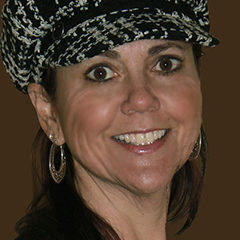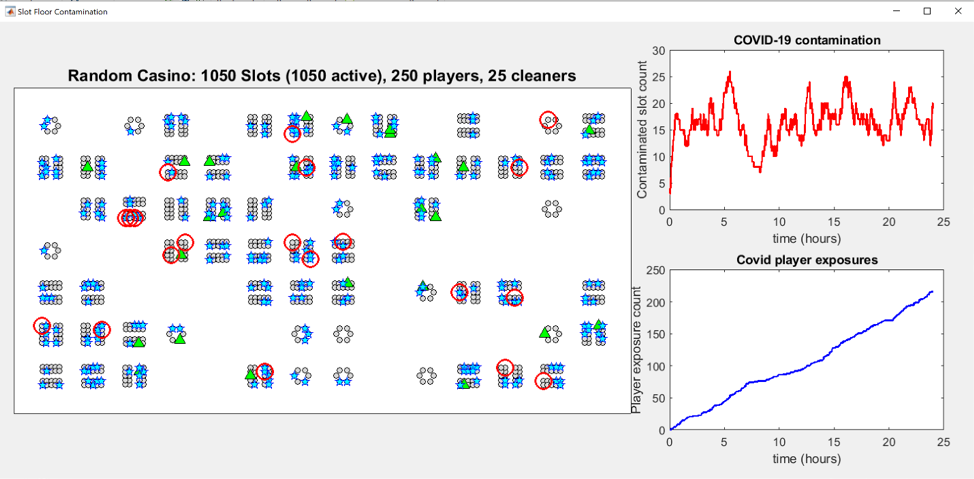Take a Look At Your Slot Floor and How Quickly Contamination Can Occur


Understanding reopening strategies using simulations of the slot floor
Jason D. Fiege, Ph.D.
CEO, nQube Data Science Inc.
Forward by Christine Faria, Executive Editor, Tribal Gaming & Hospitality Magazine
On April 29, I viewed a webinar held by CDC Gaming Seminars “Managing Your Property Reopening – The New Reality of the Slot Floor.” What I found most fascinating about the program was Jason Fiege, Ph.D.’s Monte Carlo simulations in regards to “what if” strategies in regards to how contamination can spread between machines with different cleaning protocols. I have shared the link courtesy of CDC Gaming Seminars and also asked Jason to present his findings in an article format.
It is remarkable how much life has changed since February, and especially over the past few weeks. I’ve taken to referring to my go-to Canadian news station as the “Pandemic Channel.” I miss seeing my colleagues and students in person, but I’ve become familiar with half a dozen video conferencing platforms. I have a gallon of hand sanitizer, but I’ve barely left the house since this all began. So far, we have escaped the worst of the pandemic in icy, isolated Winnipeg, Manitoba, but still, I miss the “Before Times.”
At nQube, we specialize in AI-powered solutions for casinos, focusing primarily on slot floor optimization and advanced player segmentation. With nearly every casino in the world shut down, normal operations are on pause, but this has given us time to think about strategies for reopening that emphasize player safety while also minimizing economic impact.
I lead a sort of double life. By day, I’m an astrophysics professor at the University of Manitoba, leading a group of talented students creating mathematical models and simulations aiming to understand the complex processes that form stars. In my other role as nQube’s CEO, I lead our group to develop mathematical models of slot floors, using AI methods that I invented to understand the complex, spatially-constrained, supply and demand-driven inter-relationships between players and slot machines, as we adjust slot content and locations to discover new efficiencies that increase revenue. We also have a gaming research group in collaboration with the NEXUS Data Science Institute at the university.
We are as excited about reopening casinos as anyone, but reopening needs to be done carefully and responsibly. Players have varying risk tolerance and are ultimately responsible for their own decisions. However, we believe that there is a contract of trust between casinos and their players, and in that contract, casinos bear some responsibility to take reasonable measures that encourage player safety. Many casinos will need to deal with physical distancing requirements, and constant sanitization of frequent-touch surfaces will be of paramount importance.
Lately, we’ve been developing Monte Carlo simulations to understand various reopening strategies. Monte Carlo simulations are computer experiments that can be used to investigate “what if” scenarios. They are especially useful for studying complex systems with many interacting parts – like a casino floor.
Contact contamination and cleaning strategies:
Initially, we are focusing on fighting contact contamination with cleaning strategies, health checks, and section closures. The next step is adding “proximity exposures” resulting from staff and other players spending too much time within a six-foot physical distancing bubble. Note that we are data scientists but not epidemiologists – we can track exposure events from touching contaminated surfaces, or the cumulative exposure due to proximity to an infected player, but how this translates into probability of infection is better left to medical professionals.
We simulated a random slot floor configuration containing slightly over 1000 machines, 250 players, and varying numbers of cleaning staff. At any given time, there were 3 infected players on the floor. Simulations were performed in a “steady state” (no variation in number of players) for 24 hours.
Here is a summary of what we learned:
Cleaning slot machines at random, without a method to signal that a machine has been disinfected to players, is not very effective. With 25 cleaning staff, we typically saw approximately 600-700 exposure events occur. Even increasing the number of cleaners to a 100 – an unreasonably high number, with one cleaner for every 2.5 players – the number of exposure events only decreased to about 325.
Suppose, however, that the cleaning staff tag slot machines as disinfected with a sticker or piece of tape over a button or card/ticket reader, so that players have to remove it to play, and player interest in untagged machines is reduced to 25% normal. The story changes dramatically – even with the original 25 cleaners, only about 200 exposures were observed in 24 hours of play. With 100% player compliance, exposures are virtually non-existent, only occurring in the unfortunate case of a player finding a contaminated machine before a cleaner gets to it.
The two take-home messages are that 1) tagging decontaminated machines can vastly decrease contamination events, and 2) player education is critical; players must understand the tagging mechanism and be strongly encouraged to only play disinfected machines. Cleaning staff should also quickly and cheerfully decontaminate a player’s favorite machine on request. Strategic decontamination combined with a tagging system and player education can be very effective.
Employee health checks
We ran one experiment in which there was a single infected cleaning staff member among the 25 cleaners. The results were alarming, with almost 1500 exposure events. The possibility of an infected cleaning staff member unknowingly contaminating slot machines is a nightmare scenario, which must be avoided at all costs. Employee health checks should be considered to avoid this possibility.
Section closures
We also experimented with closing entire sections of the casino, effectively concentrating both players and cleaning staff in a smaller area of the slot floor. Interestingly, we found that the number of contaminated slot machines present at any given time decreased slightly, but players seemed to find them more quickly, resulting in a net increase in exposures. We examined two scenarios, one with approximately 600 active machines, and the other with approximately 360, resulting in approximately 800 and 900 surface-contact exposures respectively. Exposures increased as the floor became more constricted. We conclude that section closures are ineffective and probably counterproductive. Moreover, proximity exposures, which we did not track, would certainly be worse in a more constricted floor.
Figure 1: A Monte Carlo simulation with 1050 slots, 250 players (3 infected), and 25 cleaning staff. Players avoid tagged contaminated slot machines 75% of the time.
It is my hope that these simulations might shed light on some of the unknowns of reopening in these unprecedented times, and provide some useful insights to help keep players safe. Perhaps some operators will be inspired to perform simulations of their own. This research is developing rapidly, and we will communicate new results as quickly as we can. Stay safe out there!







